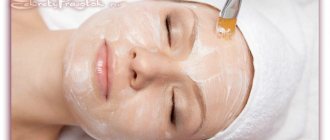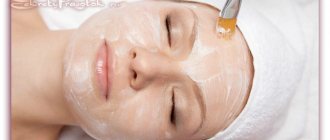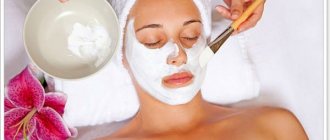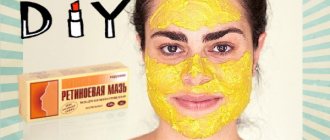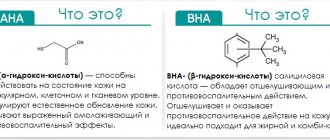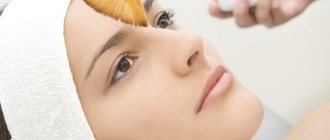Jessner peeling is one of the most popular and effective methods of healing and refreshing the skin. This effect is ensured by a special chemical composition.
Performed at home, Jessner peels are gentle, non-intensive, but effective in removing sebaceous accumulations and dead epidermal cells. The negative impact is minimal, recovery does not take much time.
Features of Jessner peeling
The recipe for a wonderful peeling was invented by physician Jessner, who served on US naval vessels. Initially, he used his invention as a shaving product that had an antiseptic effect. But gradually the cleansing and disinfectant was chosen by Hollywood celebrities, and then by the fair sex all over the world.
During peeling, a gradual effect on the skin tissue is carried out:
- at stage 1 – cleansing, improving metabolism in skin cells;
- at stage 2 – getting rid of wrinkles, obtaining a lifting effect;
- at stage 3 – elimination of deep unevenness, excess pigmentation, acne and other noticeable defects.
The number of stages is determined by the specific problems that are planned to be solved.
Jessner peeling falls into the category of chemical treatments. Skin cleansing occurs under the influence of acids, followed by their neutralization.
The basis of the chemical composition is two acids that provide accelerated regeneration and healing:
- Lactic acid. Its effect is close to that of retinoic acid. Used for effective cleansing and lightening. As a result of its use, intense peeling of the skin occurs, that is, dead epidermal tissue is actively removed, and sebaceous accumulations are removed from the pores. The acid also has a pronounced moisturizing effect, so it is useful for dry, combination, irritation-prone skin.
- Salicylic acid. Its action is to remove sebaceous shine and have an antiseptic effect. The substance is used in the fight against inflammatory formations, effectively extinguishes inflammation and dries out.
According to the intensity of the impact, Hollywood peeling, carried out at home, can be super-superficial, superficial and medium. The choice of procedure depends on the neglect of the skin:
- Super-superficial peeling is the softest and most gentle. It is sufficient for minor skin problems. It is usually chosen to eliminate minor acne and several pimples.
- Superficial peeling is more intense. It is used to eliminate excess pigmentation and rosacea. The procedure allows not only to slow down the processes of skin aging, but also to normalize the degree of oiliness of the skin for a certain time, since it affects the secretory activity of the sebaceous glands.
- Medium exposure allows you to get rid of scars, deep folds and other noticeable defects. The active components of the drug penetrate deep into the epidermis, the outer and middle epidermal layers are destroyed, due to which accelerated tissue regeneration begins.
The good thing about this home procedure is that:
- does not cause difficulties in implementation;
- provides long-lasting results;
- allows you to get rid of many skin problems;
- does not require long and complex rehabilitation;
- allows you to get rid of acne and inflammatory formations for a long time;
- varies in intensity of impact on skin tissue;
- has a small list of contraindications; is carried out at any age for any skin type;
- does not require specific preparatory measures.
But, as with all cosmetic procedures, Jessner peeling has disadvantages:
- likelihood of side effects;
- unpleasant-smelling composition;
- burning and other unpleasant sensations during application of the composition;
- the likelihood of tissue burns and other negative consequences if the procedure is performed incorrectly;
- high price of ready-made preparations for Jessner peeling;
- long course;
- carried out only in non-sunny seasons to prevent pigment formations.
Indications and contraindications for Jessner peel
Jessner peel is recommended for many skin problems. With proper implementation of the procedure and proper care during rehabilitation days, you can overcome:
- pimples, blackheads;
- rosacea;
- seborrhea;
- excessive pigmentation;
- scar formations and other irregularities;
- enlarged and clogged pores;
- skin greasiness;
- ingrown hairs;
- uneven, unhealthy skin color;
- loss of skin tissue tone.
Women of any age can take the course. But the effect on the face is especially useful in adolescence, when hormonal changes in the body lead to excessive secretion synthesis by the sebaceous glands, as well as after 35 years when the skin loses its freshness, elasticity, and healthy tone.
The Jessner Peel is suitable for all skin types. But it brings the greatest benefit to oily skin, since under the influence of acids fat accumulations on the surface of the face and in the pores are broken down.
Facial cleansing at home is contraindicated if:
- herpes virus;
- vascular pathologies on the face;
- abundant inflammatory formations on the skin;
- high body temperature;
- diabetes;
- tendency to skin allergies;
- pregnancy and lactation period.
How long does rehabilitation last?
The recovery period after a Jessner peel depends on the depth and intensity of the chemical effect:
- After superficial peeling, peeling will begin on the second day and will last 2–3 days. In general, after 4–5 days, you can evaluate the final effect of the procedure and the renewed condition of the skin;
- Peeling after a mid-peel will last longer, up to 4-5 days.
Proper care after peeling and the use of creams with sunscreen filters will allow the skin to quickly recover and the patient to return to their usual lifestyle or continue the course of transformation.
How to do a Jessner peel at home: instructions with recipe
No specific preparation is needed for the procedure. You just need to clean your face well and remove decorative cosmetics with a regular product.
It is advisable to apply a nourishing mask to your face a couple of hours before the main manipulations. This will allow the skin to prepare for acid exposure.
To remove the fatty film from the face, cosmetologists usually use special degreasing compounds. You should not use soap for this purpose at home. It is better to take a special degreaser whose acidity does not exceed 4.5 pH. Apply it evenly on the face, hold it for half a minute, and wash with warm tap water.
How to make a Jessner peel yourself, what components are needed:
- 14% salicylic acid;
- 14% lactic acid;
- 14% resorcinol;
- for dissolution, rose water or herbal decoction.
If you plan not superficial, but more intensive cleaning, then take 20% lactic acid.
Instructions for performing Jessner peeling at home, how to clean:
- The prepared preparation is applied using cotton wool or a brush. First, lubricate the forehead, move to the cheekbones, then to the chin. At the last stage, the nose and the area around it are treated. The skin around the eyelids is not touched, as it is sensitive and acids can have a negative effect on it.
- To achieve maximum effect, the peeling composition is applied in 3 layers with an interval of 5 minutes. The 3rd layer involves an intensive application, used for serious skin problems, but as a result, a crust forms on the face, which will take almost 2 weeks to heal and peel off.
- If skin problems are minor, then applying one or two layers is enough. The drug is kept on the face for 5 minutes.
- At the end of the procedure, the acidic composition is removed with a special neutralizer for acid peelings.
Common symptoms after applying the composition are burning, tightening, and redness of the skin. But if the pain is severe, then the product should be washed off immediately.
Recommendations from a cosmetologist
To ensure that the rehabilitation does not take too long, and the peeling effect lives up to all expectations, you need to follow a few tips from professionals. Care after the Jessner peeling procedure should be correct, and all the recommendations described below will help you avoid unpleasant consequences during the recovery stage.
- It is best to do Jessner peeling in the autumn-winter period. It is known that solar activity at this time of year is lower than in summer. This has the advantage of reducing the risk of skin infection through sweat and damage to the skin from ultraviolet rays.
- You need to choose a clinic or beauty salon carefully. This is a serious procedure and should only be carried out by a professional. Therefore, it is best to study reviews about the chosen place, find out whether the staff have certificates and whether they have undergone special training. It is absolutely forbidden to exfoliate or do Jessner peels, even if you have instructions.
- Before carrying out the procedure, you need to carefully study the indications and contraindications. If for some reason you cannot do this peeling, it is better to refuse it. Otherwise, you can ruin your appearance and health.
- Understand whether you really need this kind of cleaning. Consult with specialists - they can clearly see your problem. If a cosmetologist does not recommend peeling, ask what can replace such a procedure to get a similar effect.
- Follow the recommendations. Don't try to speed up the recovery period. This is a crucial stage on which the external result depends. There is no need to rush and forcibly tear the film off the skin. It's better to wait and get the best effect.
By following these Jessner Peel tips and tricks, you won't have to worry about the health of your skin. The procedure itself is overly effective, but it is important to take care of proper care after chemical exposure.
Recovery
After washing off the peeling agent, the recovery stage begins, during which it is necessary to carefully care for the face. In order for the discomfort after acid exposure to disappear faster and the skin to recover easily, you must follow the rules of post-treatment care:
- do not wash your face for the first 24 hours;
- for the first 5 days do not use skincare and decorative cosmetics (moisturizers are allowed);
- for 2 weeks, avoid prolonged exposure to the sun; when going outside, use cream with a UV filter;
- do not peel off the resulting crust (it should come off on its own);
- do not massage your face;
- do not go to the bathhouse, solarium, or swimming pool for 2 months;
- do not engage in intense sports training that causes sweating;
- to speed up regeneration, use pharmaceutical preparations Bepanten, D-Panthenol, treat the skin with them 5 times a day;
- 3 days after the procedure, to eliminate peeling, use preparations based on cosmetic oils, wax, retinol, panthenol, and plant extracts.
Efficiency of the procedure
To achieve visible results, you will need to complete a course of 10 sessions with an interval of 10 days. After the procedure, slight peeling and the formation of a brown crust are possible. But after you go through all the therapy, you will have smooth, uniform skin, without pimples and blackheads. A pleasant bonus will be a slight lifting effect and the elimination of wrinkles.
Important to know: There are several types of peeling: superficial - to eliminate acne and rosacea, super-superficial, aimed at eliminating minor skin defects and a small number of pimples, and medium penetration, which is designed to eliminate scars and improve the regeneration of the epidermis. The type of peeling is selected depending on the problem.
It is believed that after a successful procedure, the positive effect is delayed for a period of 4–8 months. Some women note that medium peeling is an excellent alternative to surgery.
Complications and side effects
If the above recommendations are not followed, unpleasant consequences arise:
- severe redness;
- irritation;
- swelling;
- itching
After removing the peel, many women feel a slight burning sensation. There is no need to worry: this is how the skin reacts to acid exposure. The skin needs 5-6 days to recover, after which time you can admire the result of the procedure.
Some women have an allergic skin reaction to lactic acid. It is accompanied by:
- changes in skin color;
- the appearance of acne;
- swelling;
- itching;
- increased skin sensitivity;
- intense peeling;
- ulceration, the appearance of open wounds.
Allergy symptoms usually go away on their own after a week or two. If a woman does not follow hygiene rules, her allergies may worsen, and the likelihood of infection or exacerbation of herpes increases.
